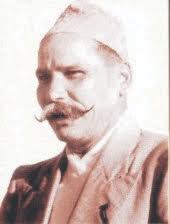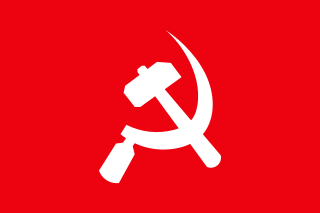
The Nepali Congress is the oldest democratic socialist political party in Nepal and the largest party in the country. The party has 870,106 members as of the party's 14th general convention in December 2021 making them the largest party by membership in Nepal. Currently the party has started online membership since the emergence of youth leaders in vital post to bring youths into the party.
Samyukta Prajatantra PartyNepal was a political party in Nepal. The party was led by Kunwar Inderjit Singh.

Shukra Raj ShastriJoshi(Nepali: शुक्रराज शास्त्री जाेशी) was a Nepalese social activist from Newar community, an intellectual and fighter for democracy who was executed by the autocratic Rana dynasty. He is one of the four martyrs of the Nepalese revolution that toppled the Rana regime. The other three are Dashrath Chand, Dharma Bhakta Mathema and Ganga Lal Shrestha.
Pushpa Lal Shrestha was a Nepali politician, considered to be the father of Nepali communism. He was the founding general secretary of the Communist Party of Nepal as well as leader.

Ganesh Man Singh was the leader of the democratic movement of 1990 in Nepal. He is revered as the Father of Democracy and the Iron-man of Nepali politics. He joined Praja Parishad to protest against the autocratic rule of the Ranas.

Kunwar Indrajit Singh, popularly known as Dr. K.I. Singh or just K.I. Singh was a Nepali politician and revolutionary who served as the 20th Prime Minister of Nepal in 1957. He was a key member of the Nepali Congress for his role in organizing the 1951 Nepali Revolution, and was a leader in its militant wing, the Muktisena, and later refused to recognize the Delhi Accord and was forced to flee the country following a revolt he took part in. In 1955 he returned and formed the United Democratic Party, and following the installation of the Panchayat system he fought for its end, for which he was jailed. Following his release, he went into self-imposed exile, but eventually returned to Nepal and was elected a member to the Rastriya Panchayat. He became known as the "Robin Hood of the Himalayas", becoming an incredibly popular figure throughout the country.

Tanka Prasad Acharya was a Nepali politician who served as the 19th Prime Minister of Nepal from 1956 to 1957. He was one of the founders and the leader of the Nepal Praja Parishad, the first political party in Nepal with the goal of removing the Rana Dynasty's dictatorship.

Dasharath Chand was a martyr of the Nepalese Democratic Movement and a politician of Nepal who was active in starting a political revolution in Nepal during the Rana rule. He was born at Baskot of Baitadi district of Nepal in 1903 AD to Sher Bahadur Chand.

General elections were held in Nepal from 18 February to 3 April 1959 to elect the 109 members of the first House of Representatives, the lower house of the Parliament of Nepal. They were held under the provisions of the 1959 constitution, which had been adopted on 12 February. More than 4.25 million people out of an overall population of about 8.55 million (1954) were eligible to vote. Voter turnout was 42.18%.

Dharma Bhakta Mathema (1909—1941) was a professional body builder as well as a founding member of Praja Parishad. He introduced modern body building techniques in Nepal, but had gained popularity for his contribution to the Nepalese struggle for freedom against the autocracy of the Rana dynasty. He was killed during the freedom movement, and is duly recognized as one of the four martyrs of Nepal of the Rana era.

Sahid Gate or Shahid Gate is a monument in Kathmandu, Nepal. The monument was inaugurated on 13 April 1961. As of 2016, there are five statues in the gate. Four men, namely Dharma Bhakta Mathema, Gangalal Shrestha, Dashrath Chand, and Shukraraj Shastri, who are considered martyrs since they stood against the 104-year-old Rana Regime, have their statues above their arms established here. On top of all is a statue of former King Tribhuvan, who, in B.S. 2007 cooperated with people to get democracy in the country. The gate was designed by Shankar Nath Rimal. King Mahendra inaugurated the monument and named it Nepal Smarak. However, people started calling it Shahid gate, a name by which it is presently called.

Ganga Lal Shrestha was a Nepalese revolutionary who was executed by the autocratic Rana regime. He is honoured as one of the four martyrs of the Nepalese revolution. He was a member of the clandestine political organisation named Nepal Praja Parishad that started a movement in 1939 to remove the Rana oligarchy and establish democracy in Nepal.
Martyr in Nepal is a term for someone who makes contributions for the welfare of the country or society. The term was originally used for individuals who died while opposing the Rana Regime which was in place in the Kingdom of Nepal from 1846 until 1951.
Nara Shumsher Jang Bahadur Rana,, was the second police chief of Nepal Police after the force was established in the year 2007 B.S.. He remained chief for two years before Gyan Bahadur Yakthumba succeeded him as police chief.
Narayan Prasad Rajbhandari, professionally known as Chittaranjan Nepali, was a Nepalese writer and historian. He received the first ever Madan Puraskar for Janaral Bhimsen Thapa Ra Tatkalin Nepal, a biographical book on the life of prime minister Bhimsen Thapa. He wrote in Nepali as well as Nepalbhasa.

The revolution of 1951 in Nepal, also referred to as Sat Salko Kranti, was a political movement against the direct rule by the Rana dynasty of Nepal which had lasted for 104 years. It marks the beginning of the political awakening and democratic movements in Nepal, and resulted in immediate abolition of the institutionalized hereditary Prime Minister system in Nepal.
Bhadrakali Mishra was a Nepali politician. In his political career lasting more than 50 years, several of which were in exile, he held numerous ministerial portfolios and was also the Chairman of King Birendra's Raj Parishad Standing Committee after the establishment of multi-party democracy in 1990.

Communism in Nepal traces its roots back to the pro-democracy movement of 1951, and the subsequent overthrow of the autocratic Rana regime and the establishment of democracy in Nepal. The communist movement in Nepal has split into factions multiple times and multiple factions have come together into a single fold at times as well. It has a history of getting banned from open political discourse, as well as multiple instances of embracing guerrilla insurgency, most notably, the Maoist insurgency in the 1990s and early 2000s that led to the Nepalese Civil War, claiming at least 17,000 lives.

Nepali National Congress was a political party in Nepal. It was formed by Dilli Raman Regmi, B. P. Koirala, Matrika Prasad Koirala, Ganesh Man Singh, Krishna Prasad Bhattarai, Mahendra Narayan Nidhi and others.














